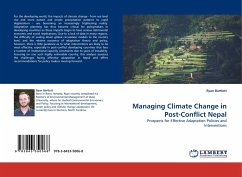For the developing world, the impacts of climate change - from sea level rise and more potent and erratic precipitation patterns to rapid deglaciation - are becoming an increasingly frightening reality. Adaptation planning has thus become critical for policymakers in developing countries as these impacts begin to have serious detrimental economic and social implications. Due to a lack of data in many regions, the difficulty of scaling down global circulation models to the country level, and the relative nascence of adaptation theory and policy, however, there is little guidance as to what interventions are likely to be most effective, especially in post-conflict developing countries that face a number of institutional capacity constraints due to years of instability. Focusing on one such highly vulnerable country, this analysis assesses the challenges facing effective adaptation in Nepal and offers recommendations for policy makers moving forward.
Bitte wählen Sie Ihr Anliegen aus.
Rechnungen
Retourenschein anfordern
Bestellstatus
Storno








